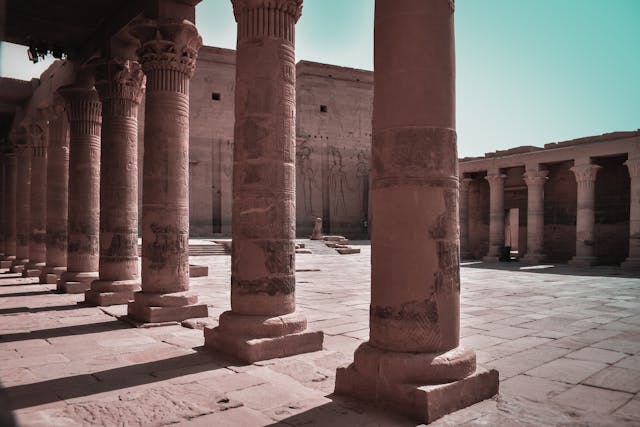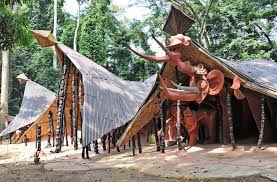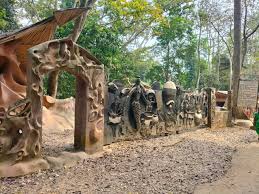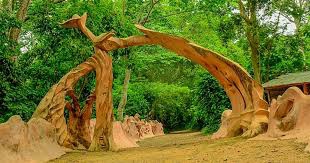




The Sacred Heart of Yoruba Land: Experiencing the Riverside and Sacred Grove of Osun
History African@africanhistory
3 months ago
The Riverside and Sacred Grove of Osun, located just outside the city of Osogbo in Osun State, is a UNESCO World Heritage Site that offers visitors a profound blend of spiritual, cultural, and natural experiences, deeply rooted in Yoruba cosmology and history.
Visitors to this site will encounter a dense, biodiverse forest, one of the last remnants of primary high forest in southern Nigeria, sprawling over 75 hectares, where the serene Osun River meanders through, regarded as the spiritual abode of Osun, the Yoruba goddess of fertility, love, and prosperity, creating an atmosphere that feels both mystical and timeless, with ancient trees, winding paths, and the gentle flow of the river contributing to a sense of sacred tranquility, though visitors should be mindful of the river’s current state, as it has been reported to be heavily polluted due to illegal gold mining and waste disposal, a stark contrast to its traditional symbolism of purity, which may prompt reflection on environmental challenges.
Within the grove, the landscape is dotted with over forty sanctuaries, shrines, sculptures, and artworks dedicated to Osun and other Yoruba deities, many of which were revitalized in the 20th century by the New Sacred Art movement, led by Austrian artist Susanne Wenger, whose integration into the Yoruba community helped restore the grove’s sanctity, with these artistic installations, characterized by their giant size and intimidating shapes, not intended to glorify the artists but to reinforce the sacredness of the space, offering visitors a visual and spiritual feast that underscores the grove’s role as a symbol of identity for the Yoruba people, though the sculptures’ modern style may spark curiosity about the blend of traditional and contemporary influences.
The grove’s historical significance is profound, as it is among the last of the sacred forests that once adjoined most Yoruba cities before urbanization, testifying to a once-widespread practice of establishing such groves, and its designation as a UNESCO site in 2005 highlights its global cultural value, with visitors able to explore five sacred places, nine worship points along the riverbanks, and two palaces, all maintained by designated priests and priestesses, providing an immersive experience into Yoruba spiritual practices, though the site’s state of preservation may vary, with reports of bush fires and neglect posing ongoing threats, adding a layer of urgency to the visit.
The annual Osun-Osogbo Festival, held in August, is a major highlight, drawing thousands of worshippers, spectators, and tourists, with the festival culminating in a vibrant procession to the main shrine, led by the Arugba, a young woman of royal lineage who carries offerings, accompanied by drumming, dancing, and elaborate costumes, reenacting the mythical first meeting between the founder of Osogbo and the goddess Osun, offering visitors a chance to witness a living tradition, though public participation has occasionally been limited due to health concerns, such as during the COVID-19 pandemic, and the festival’s management is an ongoing concern to mitigate tourism’s adverse impacts, making it wise to check current conditions before planning a visit.
The grove is also a natural herbal pharmacy, containing over 400 species of plants, more than 200 of which are known for their medicinal uses, some endemic, providing an opportunity for visitors interested in ethnobotany to appreciate the intersection of nature and traditional healing, and the presence of rare species of antelopes, monkeys, and other exotic animals, protected by prohibitions on hunting, fishing, and farming within the grove, adds a wildlife dimension to the experience, though sightings may depend on timing and luck, enhancing the sense of being in a space where nature and spirituality are intricately intertwined.
The site is located in the heart of Osogbo, about 250 kilometers from Lagos, with the journey taking around four hours by road, and while the roads are generally navigable, public transport may be crowded, making private arrangements preferable, and visitors should note that there are no major hotels or tourist facilities directly at the grove, so planning a day trip or bringing supplies, especially water and snacks, is advisable, with local guides or community members often stepping in to provide oral histories and insights, enriching the experience, though formal guides may not always be available, and the nearby Osogbo community, strongly attached to the site, adds a cultural vibrancy, offering a chance to engage with local traditions and markets. Some narratives highlight the grove’s role as a pilgrimage point for Yoruba people, with stories of healing, fertility, and wealth attributed to the goddess, and the philosophical question of environmental stewardship versus cultural reverence may linger in the minds of reflective visitors, given the river’s contamination, making it a thought-provoking destination, while recent advocacy efforts, such as those by Urban Alert, underscore the urgency of protecting this site, with reports of lead and mercury levels in the river far exceeding permissible limits, adding a layer of intrigue about the balance between tradition and modernity.
A visit to the Riverside and Sacred Grove of Osun offers a blend of spiritual immersion, cultural education, and natural beauty, set against the backdrop of a site that connects past, present, and future generations, making it a must-visit for those interested in Yoruba heritage, African spirituality, and the enduring resilience of cultural traditions, with the added resonance of standing in a place that challenges visitors to consider humanity’s relationship with nature and history.
#OsunOsogbo #SacredGrove #YorubaCulture #UNESCOHeritage #OsunRiver #CulturalHeritage #SpiritualSite #TravelNigeria #EcoTourism #OsunFestival #AfricanTradition #NatureAndSpirituality
Photo Credit: Rex clarke Adventure
